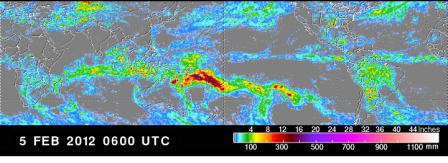on aerosols and rain patterns

Rain can be a blessing or a disaster. Rain that falls for an hour can provide water to the roots of the plants, seep under the surface, and replenish the water reservoirs. But, if the same amount of water recedes in five minutes, the results can be floods and inundation. A new study done at the Weizmann Institute of Science shows that the influence of human activity on the atmosphere probably moves the rain patterns in the direction of faster and heavier.
The study, which was recently published in the scientific journal Nature Geosciences, was conducted by Prof. Ilan Koren, research student Reuven Hayblom and Dr. Orit Altretz from the Department of Environmental Sciences and Energy Research in the Faculty of Chemistry at the institute, together with colleagues from the USA: Graham Feingold, Vanderlei Martins and Lorraine Remer. The scientists tested the intensity of the rain - that is, the amount of rain that falls in a certain period of time - in large parts of the earth. They then checked whether there was a relationship between this rate and the concentration of aerosols - tiny particles that float in the atmosphere. The aerosols are naturally found in the air, and they are the "nuclei" for the condensation of raindrops, or, higher in the atmosphere, for the condensation of ice crystals. But the amounts of aerosols today are not natural at all: burning fuels and forests added many tons of aerosols to the atmosphere in the 20th century. "For the first time, we were able to get a global picture of the ability of aerosols to change rain patterns," says Prof. Koren.
In a previous study, Prof. Korn and Feingold showed how these aerosols affect the development of clouds: large loads of particles in the air cause the creation of more droplets, but they are smaller than usual. From this it is not possible to conclude with certainty about the patterns of rain, since the development of clouds and rain is characterized by highly complex (non-linear) processes. Many factors are involved in the process, and different precipitation patterns - from light rain to storms and storms - result from completely different weather conditions. On top of that, the rain is indeed a widespread phenomenon, but it is random - a fact that makes it very difficult for efforts to establish useful and unequivocal rules regarding the causes of various phenomena.
To obtain global data on the intensity of the rain - measured in millimeters per second - the scientists turned to information from satellites. These satellites are not able to measure absolute amounts of rain, but they know how to measure the intensity of the rain of systems made up of developed clouds that produce relatively heavy rains. Data collected from several satellites over several months in 2007 (see box) allowed scientists to estimate the intensity of rain over large parts of the earth's surface in places over which developed cloud systems form, and to calculate the level of aerosol pollution in those areas.
The research group looked for possible connections between the two data, through a comparison between satellite maps of the rain intensities and maps depicting aerosol pollution by dividing them into three categories: clean, lightly polluted, and heavily polluted. The analysis revealed a close relationship: a high level of pollution appeared together with a high intensity of rain in more than 80% of the systems tested.
Is it the level of the aerosols that affects the intensity of the rain? Or maybe a third factor, such as, for example, atmospheric instability, causes both the drift of large amounts of particles into the atmosphere, and a higher intensity of rain? In an attempt to answer this question, the scientists conducted an in-depth analysis, and checked their results in relation to the hundreds of factors that may affect the rain. The most convincing fit was obtained when they analyzed their results in terms of relative atmospheric stability. They discovered that the increase in the level of aerosols is related to the increase in the intensity of the rain in all weather conditions, and in a similar way: both in stable situations, both in unstable situations, and in neutral situations. These findings indicate that an increase in the level of aerosols does increase the intensity of rainfall.
Prof. Koren believes that the phenomenon is significant mainly in areas where the rain patterns are borderline. In places that are prone to flooding anyway, a higher intensity of rain will not affect the flooding significantly, while in arid areas, the effect of the intensity of the rain is minimal compared to the constant lack of rainfall. In intermediate situations, when a greater and greater amount of the precipitation falls with such intensity that the ground is unable to absorb the water, the blessed rains may lead to negative effects.

Recycling in space
Sometimes, an unplanned surprise may actually work for the better. This was the case with the Tropical Rainfall Measurement Project (TRMM), a satellite operated by NASA and the Japanese Space Agency. When the satellite was launched, in 1997, with monitoring equipment developed in the early 90s of the 20th century, its estimated lifespan was about three years - at most. In 2005, the agencies wanted to destroy the satellite, using a controlled entry into the atmosphere (instead of simply letting it crash to Earth when the fuel runs out). The scientists objected to this, because of the importance of the information they received from him, and they appealed to the US Congress to postpone the fateful decision. "The satellite orbit allows it to cover extensive tropical areas, to exhaust the collection of rain data, and to accurately describe developed rain systems," says Prof. Koren. "The satellite continued to operate for 15 years, and thus we had an excellent tool at our disposal, which allowed us to conduct reliable and accurate research."

One response
The rain overall aligns with modern consumer culture. Eat a lot in 5 minutes, food prepared in 5 minutes. For example McDonalds. The rain is also going in this direction apparently, what a piece